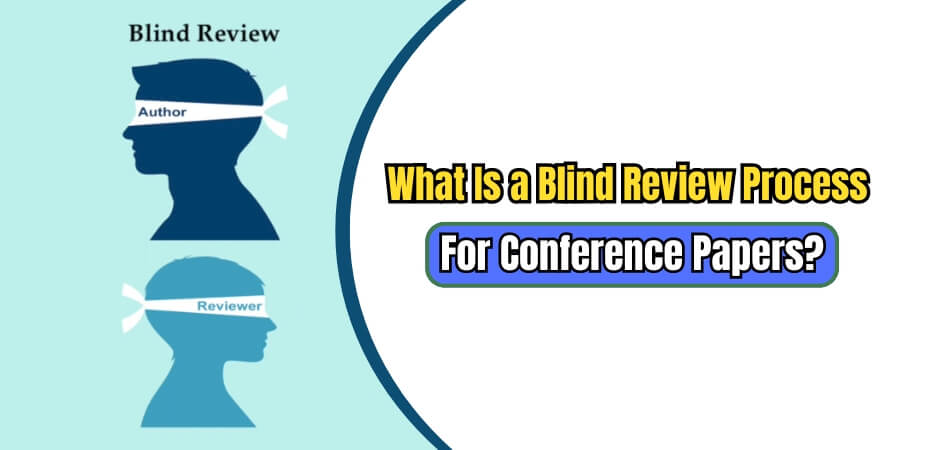For authors seeking to present their work at conferences, understanding the review process is essential. Peer reviews are conducted blindly to ensure fairness and impartiality. So, what is a blind review process for conference papers?
A blind review process for conference papers ensures anonymity in peer reviews. The authors of single-blind reviews are known to the reviewers, but their identity is kept anonymous. In a double-blind review, both authors and reviewers are anonymous, with only the editor knowing all identities.
Continue reading the rest of the article to learn more about the intricacies and benefits of the blind review process, as well as how it impacts the evaluation of your paper.
Why is it important to Submit Papers to a Conference?
It plays a critical role in shaping a researcher’s career and advancing their field if they submit papers to a conference. It’s more than just sharing your findings; it opens doors to opportunities that can significantly benefit your academic and professional life. Here are the reasons why submitting papers to conferences is so valuable:
Showcasing Your Research
Presenting at a conference gives you the chance to share your latest findings with a knowledgeable audience. It allows you to contribute meaningfully to the ongoing conversations in your area of study. Attendees often include experts who can provide insights or suggestions. This exposure can lead to more recognition and influence in your field.
Gaining Valuable Feedback
Conferences are ideal for receiving feedback from other experts and peers who review your work. Engaging with a participant of a conference offers unique perspectives that can refine your research’s quality. Honest critiques and suggestions help strengthen your arguments or methodology. This input often results in an improved and polished final version.
Expanding Your Professional Network
Presenting at conferences is a great way to meet other researchers, academics, and professionals. These gatherings create opportunities for establishing connections that could lead to collaborations. You’ll encounter people who share similar interests and are willing to support your career. Networking is vital for building a strong professional community around you.
Enhancing Academic and Professional Credibility
Publishing at prestigious conferences adds credibility to your academic profile and professional reputation. The peer review process that your work goes through validates its quality and rigor. It shows that respected experts have acknowledged your contributions to the field. This recognition helps you stand out in both academic and professional circles.
Staying Updated on Latest Trends
Engaging with contemporary research at conferences keeps you informed about the latest developments and trends. You get to learn about emerging topics, new techniques, and innovative solutions that others are exploring. This knowledge can directly impact the direction of your future research. Staying updated ensures your work remains relevant and up-to-date.
Aiding Career Advancement
Conference presentations can boost your resume, adding significant value to your academic or professional career. These experiences demonstrate that you actively participate in and contribute to your field. Some employers or academic institutions prioritize candidates with conference presentations. They see it as a sign of commitment and ongoing development.
What is a Blind Review Process for Conference Papers?
Ensure fair evaluations of conference papers by understanding the blind review process. This process helps maintain the integrity and quality of academic research. Here’s a detailed look at single-blind and double-blind review processes.
Single-Blind Review Process
In a single-blind review, the reviewers know the identities of the authors. However, the authors remain unaware of who is reviewing their work. This method can prevent bias by keeping authors’ knowledge of reviewers’ identities confidential. It allows reviewers to provide honest feedback without concerns about personal relationships.
Double-Blind Review Process
A double-blind review process ensures that both authors and reviewers remain anonymous. Neither party knows the other’s identity, promoting impartial evaluations. Only the editor is aware of all identities involved in the review. This process helps maintain objectivity and reduces potential biases in the evaluation.
Why is the Blind Review Process Important for Conference Papers?
A blind review process is crucial to maintaining the quality and integrity of conference papers. It ensures that submissions are evaluated fairly and objectively, leading to more credible and careful academic work. Here are the core reasons why the blind review process is important for conference papers:
Ensuring Objectivity
Reviewers can concentrate only on the paper’s content with the blind review process since the authors’ identities are concealed. This separation prevents personal biases based on the author’s background from influencing the evaluation. By focusing on the content, reviewers can assess the research’s quality and contribution more objectively.
The process eliminates the impact of the author’s reputation or affiliations on the review outcome. Additionally, the impact of organizer decisions on accepted conference papers can still play a role, but blind review ensures a fairer starting point. Rather than relying on external factors for assessing papers, it ensures that they are evaluated based on their merits. It is fair for authors to have their work evaluated purely on academic merit.
Promoting Fairness
Blind reviews level the playing field for all submissions, regardless of the author’s institutional affiliation or career stage. This process grants every paper an equal opportunity to be evaluated based on its quality. It removes advantages that more well-known or prestigious authors might otherwise have.
The review process ensures that every submission is assessed with the same degree of rigor and expectations. This consistency develops a sense of fairness and openness in academic evaluation. It allows lesser-known researchers to compete on the same terms as established scholars.
Maintaining Quality Assurance
The blind review process encourages thorough scrutiny, which ultimately leads to higher-quality conference papers being accepted. By focusing on content alone, reviewers provide constructive feedback aimed at improving the work. This detailed critique helps authors refine their papers before publication.
Quality assurance is maintained through a strict review process, which aims to filter out subpar submissions. This practice raises the overall standards of accepted papers, benefiting the entire academic community. It also ensures that conferences feature only high-quality research.
Reducing Potential Bias
Keeping authors’ identities hidden reduces unconscious biases related to gender, ethnicity, or other personal characteristics. This anonymity promotes an unbiased evaluation where the focus remains on the research rather than the person behind it. The process encourages a more diverse range of ideas and perspectives.
The reduction of potential bias helps prevent discrimination, ensuring all authors receive equal consideration. By minimizing the risk of prejudiced judgments, the review process supports more equitable academic practices. This approach fosters inclusivity within the academic community.
Encouraging Honest and Constructive Feedback
Anonymous reviewing allows reviewers to offer honest feedback without fear of backlash or damaging professional relationships. This candidness often leads to more thorough evaluations that identify areas for improvement. The anonymity gives reviewers the freedom to be more critical when needed.
The blind review process fosters an environment where constructive criticism is valued and expected. It ensures that reviewers can provide genuine feedback that benefits the paper’s development. Authors receive valuable insights that can enhance their research and presentation.
How to Prepare Your Paper for a Blind Review?
Preparing your paper for a blind review is essential for maintaining anonymity and ensuring a fair evaluation. Follow these steps to effectively anonymize your submission for a successful blind review process.
Step 1: Remove Identifying Information
Ensure all identifying information is removed from your paper. This includes your name, affiliation, and acknowledgments. Make sure no personal details are present in the manuscript to maintain anonymity.
Step 2: Use Anonymous Citations
Cite your previous work anonymously. Instead of using your name, refer to your past research as “Author” in both the text and references. This keeps the review process unbiased and fair.
Step 3: Check Metadata
Remove identifying information from the document’s metadata. Check the file properties to ensure your name and other details are not included. This step is crucial for maintaining complete anonymity.
Step 4: Anonymize Acknowledgments
Avoid including acknowledgments that reveal your identity. If acknowledgments are necessary, they should be omitted until after the review process. This helps preserve the integrity of the blind review.
Step 5: Avoid Institutional References
Omit specific references to your institution that can reveal your identity. Use generic terms to describe your affiliation or location. This prevents reviewers from guessing your identity based on the institution.
Step 6: Use a Neutral Tone
Write in a neutral tone that doesn’t hint at your identity. Avoid using first-person pronouns and other language that might give away your background. Maintaining a neutral tone supports the anonymous review process.
Step 7: Verify All Sections
Double-check all sections of your paper, including the introduction, methods, and conclusion, for identifying information. Ensure that every part of the paper complies with blind review standards. Thorough verification is essential for maintaining anonymity.
Step 8: Review Figures and Tables
Ensure that figures, tables, and their captions do not contain identifying information. Remove any institutional logos or names from visual elements. This ensures all parts of your submission remain anonymous.
Step 9: Prepare a Blind Title Page
Create a title page that is free of identifying details. Include only the title of your paper and a brief abstract. Submit this title page as part of your blind review submission.
Step 10: Follow Submission Guidelines
Adhere to the specific submission guidelines provided by the conference or journal. Each venue may have unique requirements for blind reviews. Following these guidelines ensures your paper meets all necessary criteria.
Tips to Help You Utilize the Blind Review Process for a Conference Paper Effectively
A successful blind review process can have a significant impact on the acceptance of your paper. From organizing your content to staying anonymous, following these steps will give you a stronger submission. Here are some tips to help you utilize the blind review process effectively.
- Anonymize Your Paper: Remove all identifying details like your name, affiliation, and acknowledgments to maintain anonymity. This helps ensure the review remains unbiased and focused on your content.
- Cite Your Work Carefully: When referencing your previous research, use third-person language to avoid revealing your identity. Sticking to a proper citation format for conference papers keeps your work professional and maintains necessary anonymity.
- Organize Clearly and Concisely: A well-organized paper helps reviewers focus on your findings without unnecessary confusion. Clarity also strengthens your arguments, making your points more persuasive and easier to follow.
- Adhere to Submission Guidelines: Review the conference’s specific submission guidelines and follow them exactly to avoid potential issues. Proper formatting and adherence signal your professionalism and commitment to quality standards.
- Emphasize Content Quality: Ensure your paper is technically strong, with thorough analysis, sound reasoning, and relevant references. High-quality content gives your paper the credibility needed to impress reviewers.
- Seek Peer Feedback: Ask colleagues for feedback before submitting to spot any overlooked weaknesses or gaps. Early feedback is essential to strengthen your paper’s overall quality and coherence.
- Respond Professionally to Feedback: If revisions are required, approach reviewer comments constructively and address each point respectfully. Professional responses reflect positively on you and enhance your paper’s chances of success.
Frequently Asked Questions about What is a Blind Review Process for Conference Papers?
The blind review process is a crucial part of evaluating conference papers, ensuring an unbiased and fair assessment. This approach keeps authors’ identities hidden, allowing reviewers to focus solely on research quality. Here are some commonly asked questions about the blind review process.
How Does Blind Review Improve the Paper’s Quality?
Blind reviews encourage reviewers to provide honest and constructive feedback on the paper’s content. Authors benefit from these insights, which help them refine and enhance their work, ultimately raising the paper’s overall quality before final acceptance.
Are Reviewers Allowed to Contact Authors During Blind Review?
No, reviewers are not allowed to contact authors directly in a blind review process. All communication goes through the conference organizers, preserving anonymity and maintaining the integrity of the review to ensure impartiality and unbiased evaluation.
Can Blind Review Prevent Conflicts of Interest?
Yes, blind review minimizes conflicts of interest by keeping authors’ and reviewers’ identities concealed. This anonymity ensures that personal relationships, affiliations, or reputations don’t impact the review, supporting fair evaluation based solely on research content and merit.
Is Blind Review Used at All Conferences?
Not all conferences use blind review, as some may prefer open or single-blind formats. However, many academic and research-oriented conferences rely on blind review to enhance fairness and quality in paper evaluation, especially in highly competitive fields.
How Are Papers Selected for Blind Review?
Papers are selected for blind review based on submission guidelines set by each conference. Authors submit anonymized manuscripts, and conference organizers assign these papers to reviewers, who assess the content without knowledge of the authors’ identities or backgrounds.
Can Blind Review Influence the Conference’s Reputation?
Yes, a fair blind review process contributes positively to a conference’s reputation. This method upholds quality standards and fairness, attracting more researchers who trust the conference for its commitment to unbiased and high-quality academic evaluation.
Last Word
To ensure fair and objective evaluations of conference papers, it is essential to understand the blind review process. This method promotes impartiality, reduces bias, and preserves academic integrity. Authors and reviewers are anonymous during the blind review process, which helps maintain high academic standards.
When preparing your paper for a blind review, it is essential to remove all identifying information, use anonymous citations, and follow specific submission guidelines. Ensuring anonymity in your manuscript supports the integrity of the blind review process. This careful preparation helps in receiving unbiased and valuable feedback.
The blind review process ensures the quality and credibility of conference papers. An unbiased academic climate is encouraged by evaluating only the research. As a result of understanding “What Is a Blind Review Process for Conference Papers?” and taking the necessary steps, authors can enhance their chances of success.








